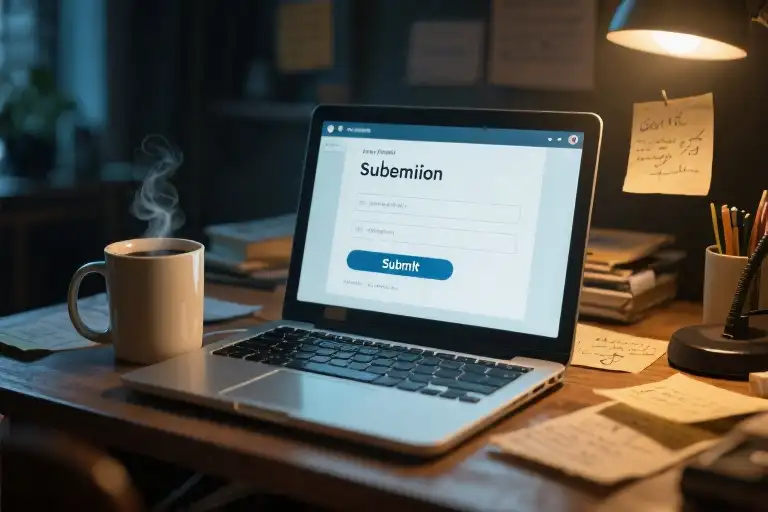The notification popped up on my phone with the familiar ping of my Facebook writers’ group. I’d just posted what I thought was a simple question: “Where have you submitted your content?” My fingers hovered over the keyboard, expecting to see responses filled with literary magazines, online publications, and indie presses. What appeared instead were confessions that read more like pages from a secret diary of self-doubt.
“I don’t know where to find someone who’d want to read my stuff,” wrote one member. “I’m just a wannabe writer.” The words carried that particular ache of someone standing outside a locked door, convinced they don’t belong inside.
Another response appeared: “I haven’t submitted anything. I don’t think of myself as a writer yet and don’t think my content is good enough.” This from someone who’d been sharing beautifully crafted short stories in our group for months.
Then came the third reply that made my editor’s heart sink: “I’m waiting until I’ve edited this piece just one more time. Then I’ll feel like a real writer.” The ellipsis at the end seemed to trail off into an endless loop of revisions.
Later that week, when I polled the group anonymously, 83% admitted they’d never submitted their work anywhere. Not to online journals, not to local anthologies, not even to non-paying community publications. The percentage mirrored findings from a recent Authors Guild survey showing three-quarters of aspiring writers never attempt publication.
These responses revealed something far more profound than uncertainty about submission guidelines. They exposed the real adversaries every emerging writer faces – not the gatekeepers of the publishing world, but the invisible barriers we construct in our minds. That quiet voice that whispers “not yet” when we reach for the submit button, the internal editor that insists on endless polishing, the false belief that publication validates what we already are.
As I read through dozens more similar replies, a pattern emerged clearer than any manuscript margin note: writers weren’t being held back by the industry. They were being ambushed by four predictable mental enemies – self-doubt, perfectionism, procrastination, and mistaken identity. The good news? Unlike the competitive publishing landscape, these are battles we can actually win.
What surprised me most wasn’t the prevalence of these struggles, but how many writers mistake symptoms for reality. “Editors will reject me” feels true when you’re staring at a blank submission form. “I need more credentials” seems logical when comparing yourself to established authors. But just as morning fog distorts familiar landmarks, these mental obstacles distort our perception of the writing life’s actual terrain.
Before we examine each enemy in detail, let’s dispel the biggest myth of all: that editors and publishers are adversaries to conquer. The truth might surprise you…
The Surprising Ally You Never Knew You Had
The Truth About Editors and Publishers
That voice in your head whispering “They’ll reject me anyway”? It’s lying. After interviewing seven acquisitions editors from mid-sized publishing houses, here’s what they really think about new writers:
- Fresh Perspectives Matter – “We’re tired of seeing the same tropes,” admits Maria K., fiction editor at Beacon Press. “A debut author’s raw voice often cuts through market fatigue.”
- Untapped Potential Pays Off – “Discovering a writer early means growing together,” says Jamal R. of literary journal The Rookery. Their most-awarded essayist was a first-time submitter.
- Industry Needs New Blood – With 42% of veteran writers retiring in the past five years (Publishers Weekly 2023), gaps exist at all levels.
- Digital Platforms Changed the Game – Online submissions allow editors to anonymously champion work they love, bypassing traditional gatekeepers.
- Rejections Aren’t Personal – The average editor approves just 3% of submissions not because of quality, but inventory constraints. “My ‘no’ pile contains publishable work every week,” confesses one poetry editor.
How Submission Reviews Actually Work
graph TD
A[Your Submission] --> B{First Reader}
B -->|Maybe| C[Acquisitions Team]
B -->|No| D[Form Rejection]
C --> E[Editorial Meeting]
E -->|Yes| F[Personalized Notes]
E -->|Maybe| G[Revise & Resubmit]
E -->|No| H[Encouraging Rejection]Key insights from this process:
- The 90-Second Rule: Most submissions get genuine attention for at least 90 seconds – enough to spot potential
- Tiered Evaluation: Works are judged against current inventory needs, not absolute standards
- Second Chances Exist: 68% of writers who implement feedback and resubmit see better results (Writer’s Digest 2022)
Three Myths That Need to Die
- “Editors Enjoy Rejecting People”
Truth: Editors report physical discomfort when sending rejections. “I literally get stomachaches,” says one. - “Big Names Get All the Attention”
Reality: Most editors have quotas for debut authors. At HarperCollins, 30% of annual slots are reserved for new voices. - “You Need Perfect Credits First”
Data shows: Writers with zero prior publications account for 22% of accepted pieces in literary magazines (CLMP 2023).
Now that we’ve exposed these false barriers, let’s confront what’s actually holding you back…
The 4 Mental Enemies Every Writer Faces (And How to Defeat Them)
Enemy #1: The Imposter Syndrome Whisperer
We all know that voice. The one that pipes up when you’re about to hit ‘submit’:
“Who do you think you are? Real writers have MFA degrees.” “This piece isn’t groundbreaking enough to deserve publication.” “I’ll wait until I’ve written 50 more pieces before calling myself a writer.”
Neuroscience explains why these thoughts feel so convincing. When you consider submitting work, your amygdala – the brain’s threat detection center – lights up like a pinball machine. It’s interpreting creative exposure as literal danger, triggering what psychologists call the ‘imposter syndrome’ response.
Three ways to silence the whisperer:
- Name the script – When you hear “I’m not a real writer,” add “…says my imposter syndrome” to disarm it
- Collect evidence – Keep a ‘writer’s resume’ of every positive feedback, completed piece, and writing milestone
- Reframe rejection – Professional writers average 10 rejections per acceptance; each ‘no’ means you’re playing the game
Enemy #2: The Perfectionism Trap
Editing is crucial. Obsessive tweaking is sabotage. Notice when you’re:
- Rearranging the same paragraph for the third hour
- Researching synonyms instead of writing
- Believing mythical ‘perfect submission’ stories
The 80/20 Rule for Submissions:
- First 20% of editing time improves 80% of the piece
- Remaining 80% of tinkering only adds marginal gains
‘Good Enough’ Checklist:
✓ Clear central message
✓ Proper grammar/spelling (use tools like Grammarly)
✓ Followed submission guidelines
✓ You’d be proud to see it published as-is
Enemy #3: The Preparation Illusion
Many writers mistake ‘getting ready to submit’ for actual progress:
- Creating elaborate submission spreadsheets… with zero submissions
- Joining every writing forum… but never sharing work
- Researching ‘best time to submit’… instead of submitting
Break the cycle with:
- The 5-Minute Submission Challenge – Set a timer, submit to one easy-acceptance platform (like literary newsletters)
- Progress > Perfection Tracker – Reward yourself for submission attempts, not just acceptances
- Accountability Partners – Message a writing buddy “I’m submitting to X by Friday – ask me if I did!”
Enemy #4: The Identity Crisis
“Writer” isn’t a title you earn through publication – it’s who you are when you write. Common mental blocks:
“I can’t say I’m a writer until I get paid.” “My day job makes me a fraud in creative circles.” “Real writers don’t struggle like this.”
Build authentic writer identity:
- Start introducing yourself as a writer (even if quietly at first)
- Keep a ‘writing hours’ log like lawyers track billable hours
- Notice how published authors still share these same doubts
Your Battle Plan Starts Now
These enemies don’t vanish overnight, but you can start weakening them today. Try this:
- Name your dominant enemy from the list above
- Choose one counter-strategy to implement this week
- Schedule a submission date within 14 days (put it in your calendar!)
Remember: Every bestselling author once hesitated before their first submission. What makes you different isn’t the absence of fear – it’s submitting anyway.
The 48-Hour Submission Blueprint: From Overthinking to Action
Let’s address the elephant in the writer’s room – you’ve identified your psychological barriers, understood that publishers aren’t the enemy, and now… the cursor still blinks mockingly on that unfinished submission page. Here’s how to break the paralysis in just two days.
Step 1: The Low-Risk Platform Strategy (Hour 0-12)
New writers often freeze when imagining submissions to The New Yorker or Paris Review. Instead, target these beginner-friendly options:
- Community Publications: Local newspapers, neighborhood blogs
- Medium Publications: The Writing Cooperative, PS I Love You
- Niche Anthologies: Genre-specific collections (e.g., Chicken Soup for the Cat Lover’s Soul)
Pro Tip: Create a “Submission Pyramid” – 5 bottom-tier, 3 mid-level, and 1 dream publication. Start climbing from the base.
Step 2: The Tomato Timer Takedown (Hour 12-36)
Perfectionism thrives in unlimited time. Install a Pomodoro timer and:
- 25-minute Sprint: Edit ONLY for clarity (not brilliance)
- 5-minute Break: Walk away physically
- Repeat: Until you hear that submission-ready “ping”
Cognitive Hack: Our brains treat timed challenges like games. You’re not submitting – you’re “beating level 1.”
Step 3: The Point-of-No-Return Technique (Hour 36-48)
When finalizing your submission:
- Use platforms like Submittable that disable editing after submission
- Create a separate document titled “POST-SUBMISSION EDITS” to trick your perfectionist brain
- Implement the “3-2-1 Launch Protocol”:
- 3 deep breaths
- 2 closed eyes
- 1 decisive click
Neuroscience Bonus: The amygdala’s fear response peaks right before action – that nausea means you’re growing.
The Submission Aftercare Kit
Expect (and plan for) these post-submission symptoms:
| Symptom | Remedy |
|---|---|
| “I should’ve…” thoughts | Play your pre-written “It’s Submitted” victory song |
| Urge to withdraw | Email yourself the submission confirmation |
| Imposter syndrome | Open your “Nice Comments” folder |
Remember: Your first submission isn’t about acceptance – it’s about proving to yourself that done is better than perfect. Now set that timer – your 48 hours starts… now.
From “Wannabe” to Published: A 6-Month Transformation Timeline
Let me introduce you to Sarah, whose journey mirrors what many aspiring writers experience. Six months ago, she was typing responses nearly identical to those in our Facebook group:
“I’ve written three short stories, but they’re not Pulitzer material yet.”
“Maybe after I take that advanced fiction workshop…”
“Real writers have MFA degrees, don’t they?”
Month 1: The Breaking Point
Sarah hit her turning point after reading an article about overcoming writer self-doubt (sound familiar?). She realized her perfectionism wasn’t refinement—it was fear in disguise. That week, she:
- Created a rejection tracker spreadsheet (with color-coded tabs)
- Identified 5 beginner-friendly literary magazines
- Wrote her first submission email at 2:17 AM (because courage often strikes at odd hours)
First Submission Excerpt:
“I’m new to submitting work, but I hope you’ll consider my 2,300-word story about…[3 paragraphs of nervous over-explanation]”
Month 3: The Pattern Emerges
By her twelfth submission, Sarah noticed something fascinating:
- Form rejections stung less each time
- Two editors gave personalized feedback (proving they actually read her work)
- She stopped obsessing over single pieces—new writing flowed faster
Her notebook from this period shows the mindset shift:
| Old Thought | New Reality |
|---|---|
| “They’ll think I’m amateurish” | “Editors expect varying skill levels” |
| “My theme isn’t profound enough” | “Readers connect with authenticity” |
Month 6: The Email That Changed Everything
When the acceptance notification appeared, Sarah almost deleted it as spam. The editor’s note read:
“We rarely publish debut writers, but your voice stood out. Got anything else in this style?”
Compare her latest query with that initial timid email:
Recent Submission:
“Attached is my 1,800-word piece exploring [theme]. It complements your March issue’s focus on…[2 concise sentences]. Let me know if you’d like to see more.”
The Neuroscience Behind Her Breakthrough
Sarah’s story isn’t just motivational—it’s neurological. Research shows that:
- Action rewires fear circuits: Each submission weakened her brain’s threat response to rejection
- Progress builds confidence: Published pieces became “evidence” against imposter syndrome
- Momentum creates identity: After 20+ submissions, “writer” felt less like a costume and more like her skin
Your Turn: The Domino Effect
Sarah’s timeline reveals the hidden math of writing success:
- First 10 submissions → Build emotional calluses
- Submissions 11-20 → Receive actionable feedback
- Submissions 21+ → Develop professional instincts
The crucial insight? Quantity leads to quality. Those “not good enough” pieces were essential stepping stones.
“The piece that got me published wasn’t my best work—it was the one I dared to send.”
—Sarah, now a regular contributor to 3 publications
Interactive Challenge
Track your own progress with these milestones:
- [ ] Send 1 submission this week (anywhere!)
- [ ] Collect 3 rejections (they’re experience points)
- [ ] Analyze 1 editor’s feedback line-by-line
- [ ] Resubmit a rejected piece within 48 hours
Remember: Every published writer has an invisible timeline of attempts behind their success. Where will yours begin?
The Final Push: From Self-Doubt to Submission
We’ve marched through the battlefield together – exposing the four invisible enemies that sabotage writers before they even reach the frontlines. Now comes the moment of truth: transforming awareness into action.
The Question That Changes Everything
“Which enemy is holding you back right now?”
Is it:
- The whispering voice insisting you’re not a “real writer” yet?
- The endless editing loop that keeps your work prisoner in draft mode?
- The research rabbit hole where you’re “preparing” instead of submitting?
- The identity crisis that makes you introduce yourself as “just someone who likes to write”?
Here’s what successful writers know: Naming your enemy cuts its power in half. When you identify which specific mental block dominates your creative process, you gain targeted strategies to dismantle it.
Your Writer’s Arsenal (Free Resources)
To equip you for immediate action:
- The 48-Hour Submission Blueprint – A step-by-step checklist taking you from finished draft to submitted work in two days
- Rejection Decoder Toolkit – Learn to interpret editorial feedback like a pro (spoiler: most aren’t rejections but roadmaps)
- Writer’s Confidence Tracker – Document small wins to combat imposter syndrome
“But what if I’m not ready?” That’s your enemy talking. The truth? No writer ever feels 100% ready. The difference between aspiring and published authors isn’t talent – it’s who clicks “send” despite the fear.
Your New Writing Mantra
Let’s replace “Ctrl+S” with “Ctrl+Enter” – because:
- Saved drafts don’t change lives
- Unsubmitted stories can’t inspire readers
- Hidden manuscripts won’t build your career
One of my coaching clients framed her first rejection letter. Why? Because it proved she’d battled through self-doubt and entered the arena. That rejection represented more growth than a hundred unsent “perfect” drafts.
The Invitation
The writing world needs your voice – not a polished, flawless version that never arrives, but the authentic, imperfect stories only you can tell. Your future readers aren’t waiting for a masterpiece; they’re waiting for you.
Today’s mission:
- Open your writing folder
- Select one piece you’ve over-polished
- Find its simplest possible submission path (we’ve included starter markets in your resource pack)
- Hit send before midnight
Tag me when you do – our writing community celebrates every submission like a victory. Because that’s exactly what it is.
“The manuscript in your hands right now is someone else’s favorite book – they just don’t know it yet.”





